When it comes to digital marketing, marketers have an endless number of tools and strategies at their disposal. But what if they could add another layer of intelligence to their marketing efforts?
That's exactly what third-party data does. Even in cookieless times, third-party data offers marketers a deeper understanding of their audiences, helping them reach more prospects through effective campaigns. To learn more about the benefits and use cases of third-party data, read on!
How Do Marketers Benefit From Third-Party Data?
In today’s digital world, marketers can no longer rely on one-off methods for reaching their audiences. They need real-time data that is actionable, relevant and accurate to help them connect with consumers at every stage of the buyer journey.
When combined with first-party data, third-party data allows marketers to build a comprehensive, 360-degree picture of their audiences, from the first touchpoint to conversion. Let's explore more benefits of this marketing goldmine:
1. Reach
Marketers can use third-party data to reach more prospects and increase their targetable customer base. For example, a travel company can use third-party data to identify and target audiences that have traveled to specific destinations, or a financial services company can target prospects who have recently made large purchases.
2. Engage
Third-party data is ideal for engaging existing and future customers using an omnichannel digital marketing strategy. Integrating seamlessly into a brand's existing technology stack, third-party data helps marketers activate newly enriched audiences on digital display, video, mobile and social channels.
3. Identify
Brands that use third-party data enjoy the benefit of being able to identify new audiences and opportunities for growth through sophisticated modeling and analysis. In addition, they can generate new personas and gain insight into their audiences’ behavior, preferences and interests.
4. Personalize
Marketing professionals can use third-party data to personalize their interactions with consumers on a deeper level by leveraging it to deliver more relevant messaging, content and experiences. This can help them increase engagement rates, boost sales and drive ROI for their marketing campaigns.
What Does Using Third-Party Data Look Like?
Third-party data can be leveraged by any industry or vertical to power the entire marketing funnel — from entertainment to finance and everything in between. It's most effective when used by marketers who understand the value of consumer data and is especially well-suited for companies seeking to grow their database, increase engagement and drive revenue.
Moreover, here are some examples of how marketers can use third-party data to improve their marketing strategy:
1. Customer Insights
By overlapping first-party data with third-party information, brands uncover insights and traits of their customers. While marketers may initially know a potential buyer's name, address, email and transaction history, third-party data gives them additional insights such as interests, intent, employment and lifestyle.
For example, a retailer may use third-party data to better understand their customers' preferences. Knowing what types of consumer brands a customer is interested in — as well as how frequently they purchase them — will help the retailer develop a better marketing strategy.
2. Persona Profiling
Persona profiling allows marketers to better understand their customers and target them with relevant messaging. By creating detailed buyer personas using enriched customer insights provided by third-party data, marketers are able to create more personal messages that resonate with a customer's unique needs.
Furthermore, this information can be used to develop targeted advertising campaigns, by identifying the interests of each persona and tailoring content accordingly.
3. Personalization
Third-party data enables marketers to optimize the customer experience by tailoring the content of their messages and personalizing their brand experience — which is often sought out by consumers in today's crowded digital environment.
4. Lookalike Modeling
Brands leveraging the rich set of information available in third-party data can create lookalike model audiences based on qualified consumer traits and personas in order to acquire similar prospects.
5. Prospecting & Targeting
The ability to reach the right audience at the right time with highly personalized messages is an essential component of marketing success today.
Users of third-party data have seen up to a 4.2x increase in prospect reach due to highly-specific targeting strategies.
Gain Actionable Insights With Eyeota
The importance of first-party data cannot be overstated. However, marketers are coming to understand that it is just one piece in a more comprehensive approach.
In this increasingly privacy-conscious world, third-party data sets are still viable — but finding the right partner is key.
Eyeota uses a wide variety of trusted, reliable sources across the globe to augment brands' existing first-party data and provide marketers with actionable insights, allowing for more personalized content and fine-tuned targeting strategies to drive optimal campaign performance.
Ready to get started? Connect directly with an Audience Specialist to find out more.
